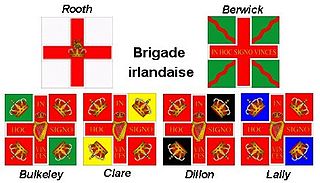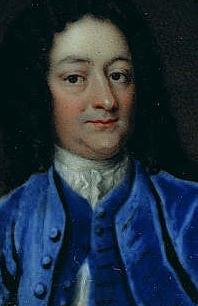
1745 (MDCCXLV) was a common year starting on Friday of the Gregorian calendar and a common year starting on Tuesday of the Julian calendar, the 1745th year of the Common Era (CE) and Anno Domini (AD) designations, the 745th year of the 2nd millennium, the 45th year of the 18th century, and the 6th year of the 1740s decade. As of the start of 1745, the Gregorian calendar was 11 days ahead of the Julian calendar, which remained in localized use until 1923.

George II was King of Great Britain and Ireland, Duke of Brunswick-Lüneburg (Hanover) and a prince-elector of the Holy Roman Empire from 11 June 1727 (O.S.) until his death in 1760.

The War of the Austrian Succession was a European conflict fought between 1740 and 1748, primarily in Central Europe, the Austrian Netherlands, Italy, the Atlantic Ocean and Mediterranean Sea. Related conflicts include King George's War in North America, the War of Jenkins' Ear, the First Carnatic War, and the First and Second Silesian Wars.

The Battle of Dettingen took place on 27 June 1743 during the War of the Austrian Succession at Dettingen in the Electorate of Mainz, Holy Roman Empire. It was fought between a Pragmatic Army, composed of the British, Hanoverian and Austrian troops, and a French army commanded by the duc de Noailles.

Prince William Augustus, Duke of Cumberland was the third and youngest son of King George II of Great Britain and Ireland and his wife, Caroline of Ansbach. He was Duke of Cumberland from 1726. He is best remembered for his role in putting down the Jacobite Rising at the Battle of Culloden in 1746, which made him popular in certain parts of Britain. He is often referred to by the nickname given to him by his Tory opponents: 'Butcher' Cumberland.

The Battle of Fontenoy took place on 11 May 1745 during the War of the Austrian Succession, near Tournai, then part of the Austrian Netherlands, now in Belgium. A French army of 50,000 under Marshal Saxe defeated a Pragmatic Army of roughly the same size, led by the Duke of Cumberland.

The Silesian Wars were three wars fought in the mid-18th century between Prussia and Habsburg Austria for control of the Central European region of Silesia. The First (1740–1742) and Second (1744–1745) Silesian Wars formed parts of the wider War of the Austrian Succession, in which Prussia was a member of a coalition seeking territorial gain at Austria's expense. The Third Silesian War (1756–1763) was a theatre of the global Seven Years' War, in which Austria in turn led a coalition of powers aiming to seize Prussian territory.

Field Marshal John Dalrymple, 2nd Earl of Stair, was a Scottish soldier and diplomat. He served in the Nine Years' War and the War of the Spanish Succession and, after a period as British Ambassador in Paris, became a military commander at the Battle of Dettingen during the War of the Austrian Succession.

The Irish Brigade was a brigade in the French Royal Army composed of Irish exiles, led by Lord Mountcashel. It was formed in May 1690 when five Jacobite regiments were sent from Ireland to France in exchange for a larger force of French infantry who were sent to fight in the Williamite War in Ireland. The regiments comprising the Irish Brigade retained their special status as foreign units in the French Army until nationalised in 1791.

Henry Hawley was a British army officer who served in the wars of the first half of the 18th century. He fought in a number of significant battles, including the Capture of Vigo in 1719, Dettingen, Fontenoy and Culloden.

The Electorate of Hanover was an electorate of the Holy Roman Empire located in northwestern Germany that arose from the Principality of Calenberg. Although formally known as the Electorate of Brunswick-Lüneburg, it made Hanover its capital city. For most of its existence, the electorate was ruled in personal union with Great Britain and Ireland following the Hanoverian Succession.

The Battle of Rocoux took place on 11 October 1746 during the War of the Austrian Succession, at Rocourt, near Liège in the Prince-Bishopric of Liège, now modern Belgium. It was fought between a French army under Marshal Saxe and a combined British, Dutch, German and Austrian force led by Charles of Lorraine, John Ligonier and Prince Waldeck.

The Battle of Lauffeld took place on 2 July 1747, during the War of the Austrian Succession. Fought between the towns of Tongeren in modern Belgium, and the Dutch city of Maastricht, a French army of 80,000 under Marshal Saxe defeated a Pragmatic Army of 120,000, led by the Duke of Cumberland.

Lieutenant General Humphrey Bland was an Irish professional soldier, whose career in the British Army began in 1704 during the War of the Spanish Succession and ended in 1756.

The Jacobite rising of 1745 was an attempt by Charles Edward Stuart to regain the British throne for his father, James Francis Edward Stuart. It took place during the War of the Austrian Succession, when the bulk of the British Army was fighting in mainland Europe, and proved to be the last in a series of revolts that began in March 1689, with major outbreaks in 1715 and 1719.

The Fall of Ghent occurred on 15 July 1745 during the War of the Austrian Succession when a 5,000 strong French force under Ulrich Frédéric Woldemar, Comte de Lowendal surprised and captured the town of Ghent in the Austrian Netherlands. The Allied garrison offered little resistance.
The Battle of Melle was an encounter battle fought on 9 July 1745, during the War of the Austrian Succession, between forces of the Pragmatic Allies and the French. After their defeat at Fontenoy in May, the Duke of Cumberland, Allied commander in Flanders, was under pressure from the Austrians to defend Brussels. He also wanted to protect the key port of Ghent, a major supply depot threatened by the French advance into West Flanders.

The Battle of Fontenoy, 11 May 1745, was a major engagement of the War of the Austrian Succession, fought between the forces of the Pragmatic Army – comprising mainly Dutch, British, and Hanoverian troops, as well a relatively small contingent of Austrians under the command of the Duke of Cumberland – and a French army under the titular command of King Louis XV of France, with actual field command held by Maurice de Saxe, commander of Louis XV's forces in the Low Countries.

Lieutenant-General Sir James Campbell KB was a Scottish military officer and Whig politician who sat in the British House of Commons from 1727 to 1741, representing the constituency of Ayrshire. A distinguished cavalry officer, Campbell began his military career at a young age and fought in several conflicts of the Second Hundred Years' War, along with serving as the governor of Edinburgh Castle from 1738 until his death in 1745.

The Hanoverian Army was the standing army of the Electorate of Hanover from the seventeenth century onwards. From 1692 to 1803 it acted in defence of the electorate. Following the Hanoverian Succession of 1714, this was in conjunction with the British Army with which it shared a monarch. Hanoverian troops fought in the War of the Austrian Succession, Seven Years' War and American War of Independence during the eighteenth century.



















